17 Aleatoric Music
Aleatoric Music
In the post-World War II era, a cadre of composers in both Europe and the United States who tired of the complex mechanisms and sophisticated techniques established earlier in the century began to envision direct ways of working with musical ideas that could incorporate improvisation, chance, and indeterminacy to various degrees. In so doing, they managed to create new paradigms of composition in which the detailed materials the composer normally developed were replaced with a more general control of the broader parameters which constitute sound in time.
Although there are as many methods to accomplish this new-found compositional freedom as there are composers, we will explore some techniques to help guide the student should one wish to further investigate this musical avenue. The two main concerns involve live aleatoric music, wherein the composer establishes a means to allow each performance of a particular piece to be unique through some type of controlled improvisation, and pre-compositional indeterminacy, in which case the score is fixed in the traditional manner, but the process that the composer took to reach that point involved chance. Both categories fall under the genre of aleatoric music, from the Latin root alea, which means dice.
Index
A. Live Aleatoric Music
The central question that the composer must ask in terms of live aleatoric music is what parameters of the music need to be defined and to what degree are the materials to be controlled. We will create two original chamber works to explore some ways that this can be answered.
Defining Structure Without Specific Materials. One method developed by the American composer Morton Feldman (1926-1987) is to define only the number of notes to be played in a specified duration. The score is presented as a grid that reads in units of time from left to right, similarly to a standard score, with a numerical value placed within the grid squares to provide the performer the specified number of pitches. In this mode of thought, we will create a quasi-Feldman piece. For most aleatoric pieces, written notes should be provided as to how to realize the intentions of the composer. This is as important for proper execution as it is for the Baroque keyboardist to understand figured bass in order to perform correctly.
It is crucial to realize that while a great deal of freedom is allotted to the performer, the composer can maintain a significant degree of organizational control. In our piece, we have begun by defining the orchestration (four players, one from each instrumental family) and the time regions (twenty at four seconds apiece). But now we need to develop a form to build an integral dynamic structure.
The twenty regions are grouped into five, four-unit segments. The first four are cycles consist of a sequence of solo, duo, trio, and duo regions. Each possible permutation of instrumental ensembles is presented over the course of the cycles with the last four units presenting the full quartet for the first and only time. Regarding the amount of notes, we decided to have a less dense texture overall, with a maximum of only six per region, but often limited to only one to three.
What remains undefined, and left open to improvisation, is the pitch, dynamic envelope, timbre (beyond instrument type), and duration of each of the notes. As well, when the notes are to be attacked within each region, and if they are to be connected, are in the realm of the performers’ individual decisions. Below, we have created a sample performance of the piece – but of course, each time the composition would be performed, while it would retain certain principles inherent in the prescribed form, it would sound quite different.
Listen: Track 37

Defining Materials Without Specific Structure. Another system developed by the German composer Karlheinz Stockhausen (b. 1928) provides musical materials for the performers but allows for a variety of orders and juxtapositions that they can be articulated. In the piece below, we have composed brief musical fragments that are spread across the page to disassociate each from their neighbors. Many of the fragments have related material (some even are retrogrades/transpositions of others, harkening back to dodecaphonic procedures). The directions we have construed for this piece are as follows:
The fragments can be played in any order by any group of three instrumentalists and at any dynamic. If the fragment is not in the range of the instrumentalist, octave transpositions should be employed. Allow for any duration between the fragments. Agree on a tempo so that the fragments are performed at relatively the same speed. The musicians should feel at liberty to repeat any fragment and/or avoid any fragment. The musicians should agree on a set time for the piece and hold their final notes when this period is crossed so that they can cut-off together.
Based on these instructions, the performers can choose to interact with one another – echoing each other’s chosen fragments – or choose to go one’s own way. They can build dramatic climaxes through listening to how each player develops their dynamic contours and blend or overlap these nuances, or by ignoring this can create strong reliefs between the resulting terraced intensities. Silences, texture changes, and unforeseen connections between materials will be the result of chance juxtapositions. In essence this communal manner of performing is one of the integral aesthetic and societal functions behind this particular species of music making. Some composers, such as Cornelius Cardew (1936-1981) and Christian Wolff (b.1934), use this compositional approach as an integral expression of their political perspective.
Of course, although the realization of a score of this kind will be unique with each performance, the aesthetic can be controlled by the composer based on the contents of the individual fragments, whether chromatic or diatonic, scalar or with more leaps. In our sample performance, the three instrumentalists are flute, clarinet, and violin. The clarinetist plays the music so it sounds as written (rather than transposed) and the violinist performs the fragments with staccato markings as pizzicati.
Listen: Track 38
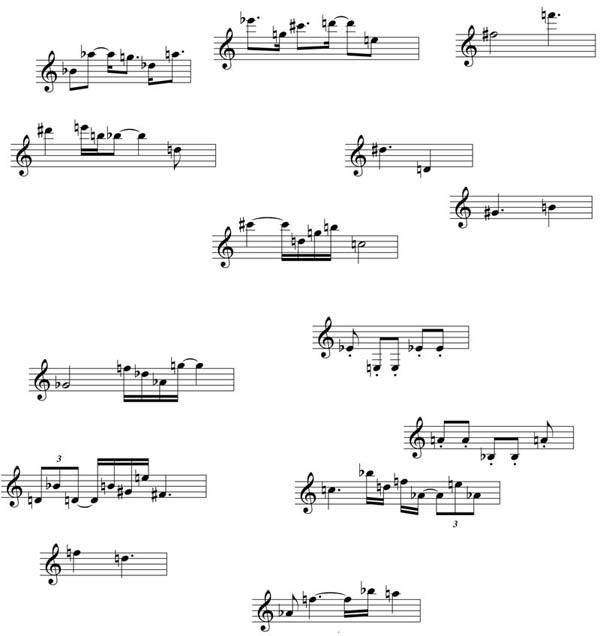
Less Defined Aleatoric Procedures. Further allowances in terms of freedom allotted to the performer have been explored by composers such as John Cage (1912-1992), André Boucourechliev (1925-1997), and Sylvano Bussotti (b. 1931) in which drawings, images, or other non-musical symbols are used to suggest musical ideas to the performers. These generally are called graphic notation scores and many border on non-composition approaches to music making since the author often controls none of the parameters of the sound structure and rely on the musicians’ interpretation almost entirely. However, some can be seen as a new approach to the concept of composition and place the musicians in unique situations.
B. Pre-Compositional Indeterminacy
When the intention is to present a traditional score based on procedures involving chance, the composer needs to decide which musical parameters are to be determined through some method of indeterminacy, and what the method itself will entail. The aforementioned American composer, John Cage, employed a variety of methods, including using characters of the I Ching (an ancient text featuring a series of symbols that relate to Chinese cosmology and philosophy), while the Greek composer Iannis Xenakis (1922-2001) used scientific data compiled by a computer in some of his earlier compositions to provide him with a body of source material (pitches, rhythms, and other parameters) from which he made conscious decisions as to what would go into the final score. One composer/artist, Dick Higgins (1938-1998), even used a machine gun to puncture holes into score paper that he then distributed for performance. Whatever the approach, it often asks the composer to draw upon extra-musical concepts that can imaginatively be woven into a musical context.
Developing a Method to Provide for Indeterminacy. For our brief composition below, we will use a simple, computer-based random number generator to first choose twelve sets of twelve notes (one for each possible pitch) wherein each set does not have to contain unique numbers. These numbers will then be converted into pitches (see chart below). Following this, the generator will be used to create twelve more sets of numbers, which will be converted into durations, and twelve sets for intensity (see chart below).
Applying Indeterminately Derived Raw Material. We will now have three groups of twelve sets of figures, which will be compiled at the discretion of the composer into a final table of twelve sets of notes with assigned durations and intensities. We will then assign two sets to each of six instruments. These sets will be divided into single cells, cut out, and dropped onto score paper prepared for each part by the composer (inspired by the 1917 collage, Squares Arranged According to the Laws of Chance by artist Jean Arp (1886-1966)). This outcome will determine when in the piece each note will occur. However, it will be at the discretion of the composer as to what register each note will sound for the particular instrument in the final engraved scores (note, only parts in a piece such as this are necessary since there is no inherent organization between the instruments).
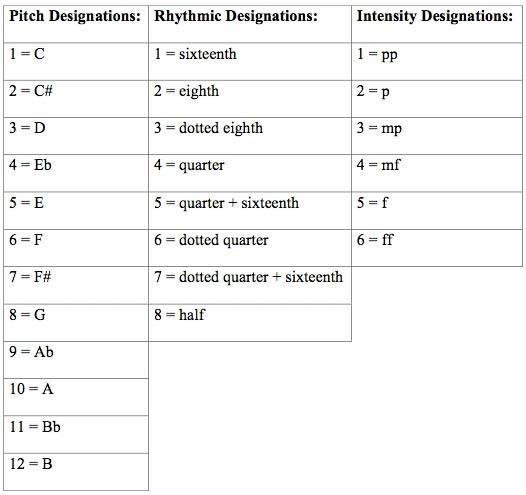
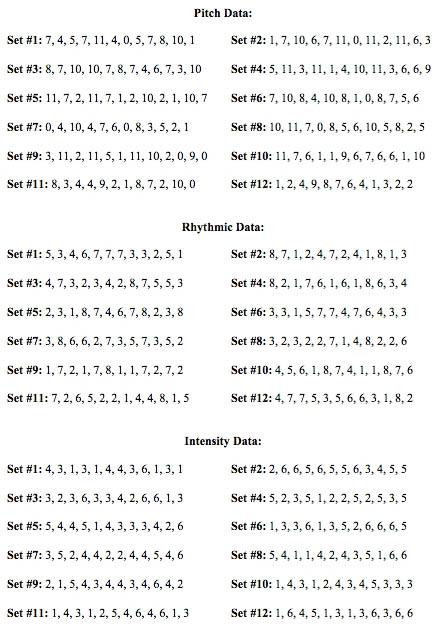
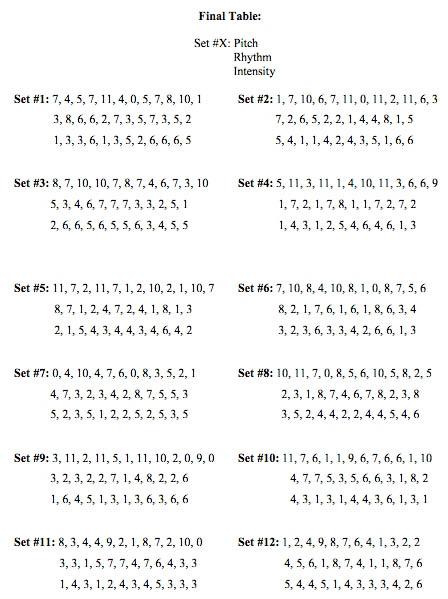
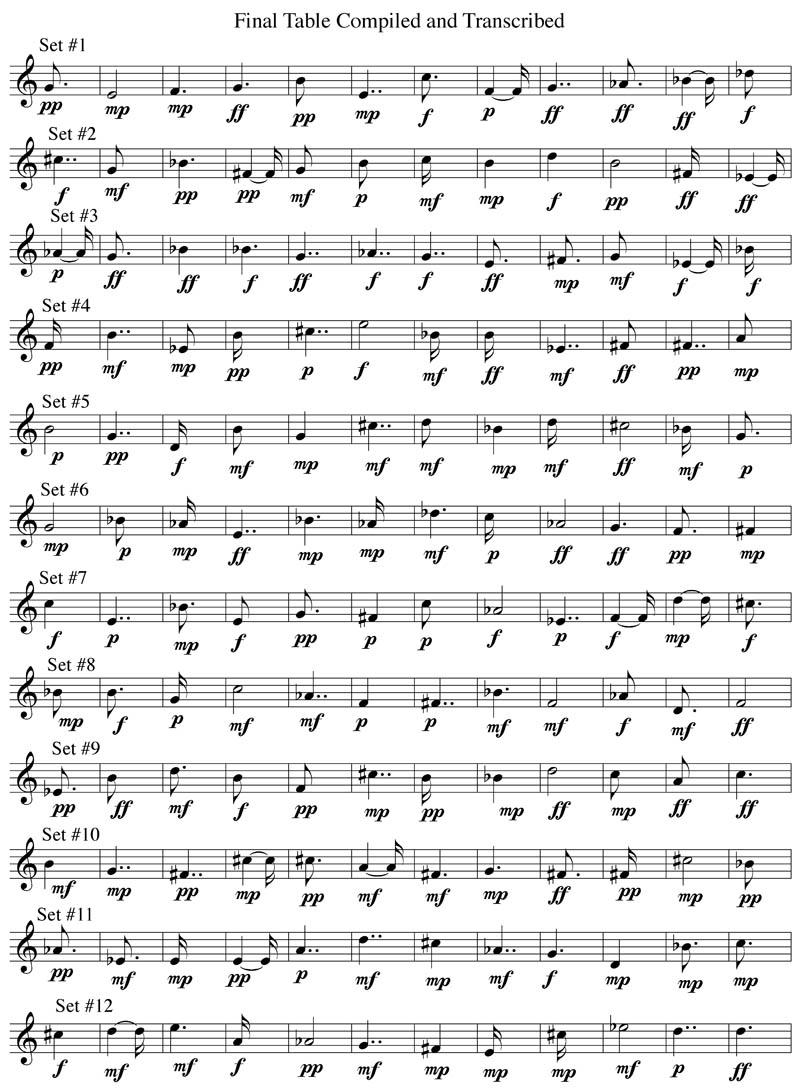
Final Score. For our piece, we have employed the following instruments (and their associated sets):
Oboe (Sets #1-2)
Clarinet (Sets #3-4)
French Horn (Sets #5-6)
Bassoon (Sets #7-8)
Violin (Sets #9-10)
Violoncello (Sets #11-12)
Note that instruments where duration is difficult to control in the type of isolated-attack planned texture (such as harp, marimba, and the like) were avoided. Sample part:
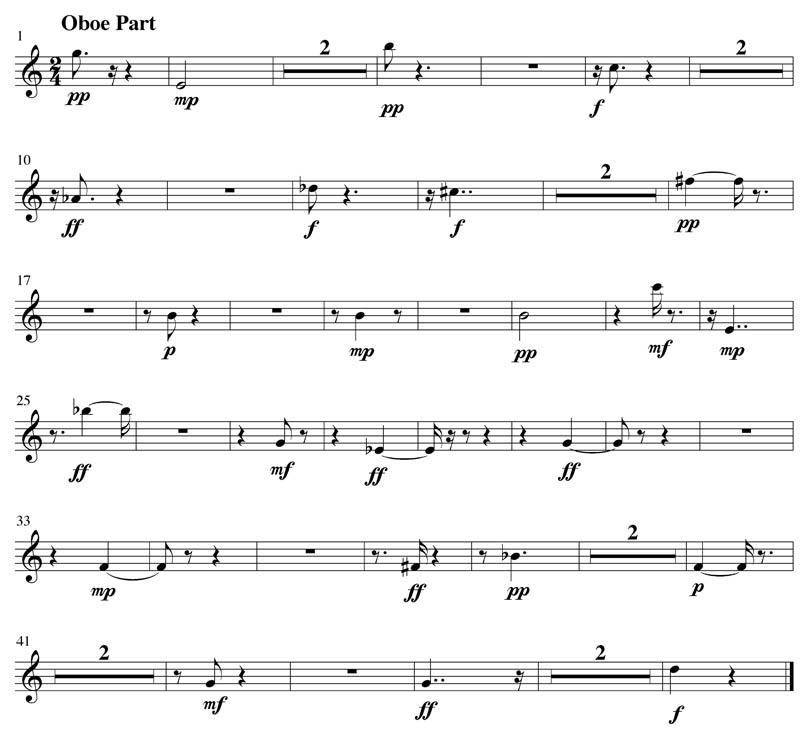
Aesthetics. In all, the composer only decided on the instrumentation, tempo, overall length (48 bars of 2/4 time – based on twice the number of total pitches each instrument is allotted and the greatest duration of any one note), number of attacks, register for each attack, and the limitations placed on the chance data – a computer and gravity determined the remainder of the piece. The aesthetic here is partially based on a philosophical perspective regarding the purpose of art to include ways to liberate artists from their self-conscious egos and, in turn, allow for experiences that lie beyond certain kinds of creative manipulation to occur.
Listen: Track 39

